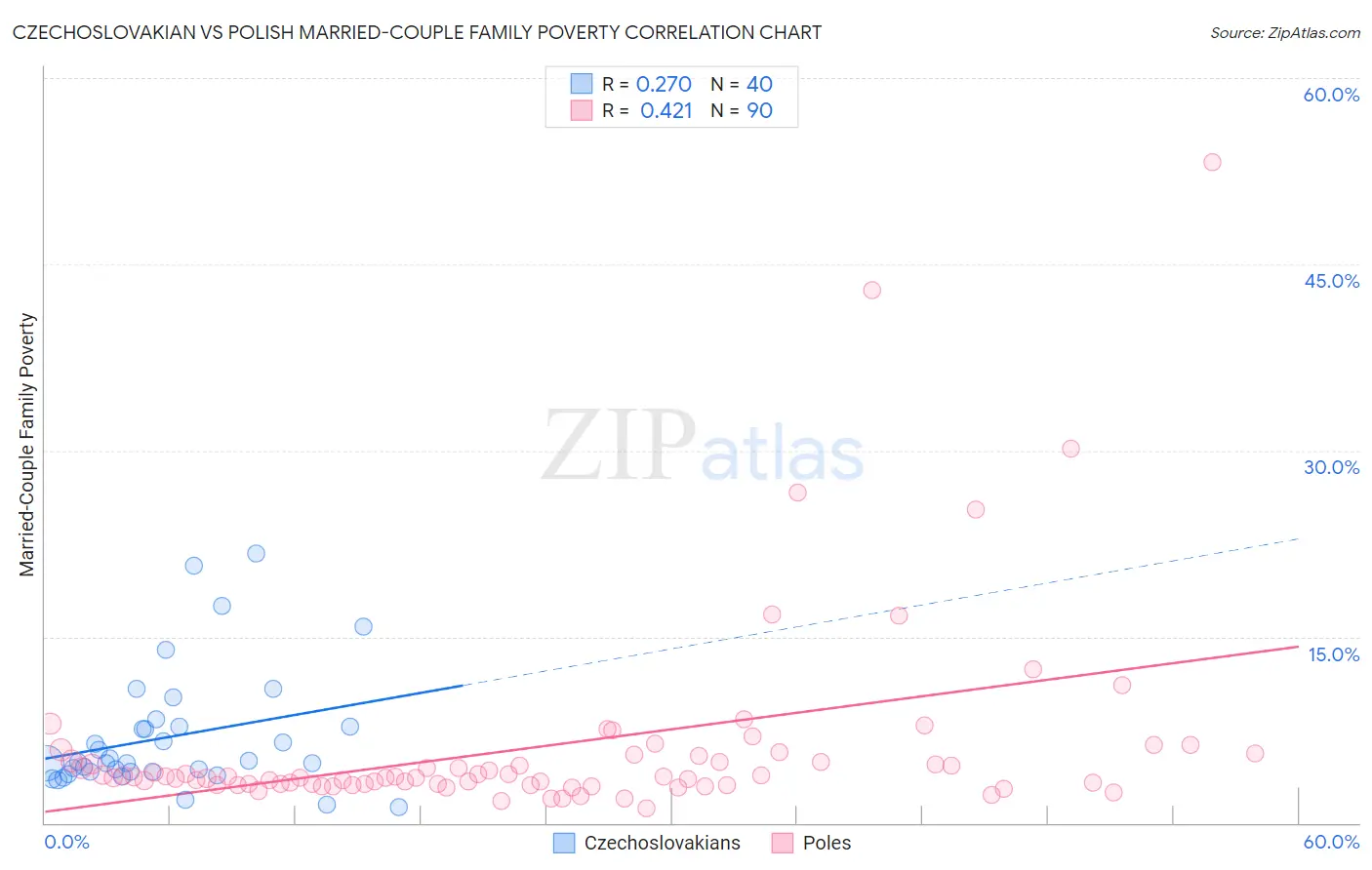Czechoslovakian vs Polish Married-Couple Family Poverty
COMPARE
Czechoslovakian
Polish
Married-Couple Family Poverty
Married-Couple Family Poverty Comparison
Czechoslovakians
Poles
4.4%
MARRIED-COUPLE FAMILY POVERTY
99.7/ 100
METRIC RATING
58th/ 347
METRIC RANK
4.0%
MARRIED-COUPLE FAMILY POVERTY
100.0/ 100
METRIC RATING
15th/ 347
METRIC RANK
Czechoslovakian vs Polish Married-Couple Family Poverty Correlation Chart
The statistical analysis conducted on geographies consisting of 364,959,932 people shows a weak positive correlation between the proportion of Czechoslovakians and poverty level among married-couple families in the United States with a correlation coefficient (R) of 0.270 and weighted average of 4.4%. Similarly, the statistical analysis conducted on geographies consisting of 546,544,798 people shows a moderate positive correlation between the proportion of Poles and poverty level among married-couple families in the United States with a correlation coefficient (R) of 0.421 and weighted average of 4.0%, a difference of 8.1%.

Married-Couple Family Poverty Correlation Summary
| Measurement | Czechoslovakian | Polish |
| Minimum | 1.3% | 1.1% |
| Maximum | 21.7% | 53.2% |
| Range | 20.4% | 52.1% |
| Mean | 6.9% | 6.2% |
| Median | 4.9% | 3.7% |
| Interquartile 25% (IQ1) | 4.2% | 3.1% |
| Interquartile 75% (IQ3) | 7.7% | 5.4% |
| Interquartile Range (IQR) | 3.6% | 2.3% |
| Standard Deviation (Sample) | 4.9% | 8.1% |
| Standard Deviation (Population) | 4.8% | 8.0% |
Similar Demographics by Married-Couple Family Poverty
Demographics Similar to Czechoslovakians by Married-Couple Family Poverty
In terms of married-couple family poverty, the demographic groups most similar to Czechoslovakians are Immigrants from Zimbabwe (4.3%, a difference of 0.090%), Immigrants from Netherlands (4.3%, a difference of 0.090%), French (4.3%, a difference of 0.24%), Austrian (4.3%, a difference of 0.27%), and Welsh (4.3%, a difference of 0.53%).
| Demographics | Rating | Rank | Married-Couple Family Poverty |
| Immigrants | Lithuania | 99.7 /100 | #51 | Exceptional 4.3% |
| Russians | 99.7 /100 | #52 | Exceptional 4.3% |
| Welsh | 99.7 /100 | #53 | Exceptional 4.3% |
| Austrians | 99.7 /100 | #54 | Exceptional 4.3% |
| French | 99.7 /100 | #55 | Exceptional 4.3% |
| Immigrants | Zimbabwe | 99.7 /100 | #56 | Exceptional 4.3% |
| Immigrants | Netherlands | 99.7 /100 | #57 | Exceptional 4.3% |
| Czechoslovakians | 99.7 /100 | #58 | Exceptional 4.4% |
| Immigrants | Sweden | 99.6 /100 | #59 | Exceptional 4.4% |
| Tlingit-Haida | 99.6 /100 | #60 | Exceptional 4.4% |
| Okinawans | 99.6 /100 | #61 | Exceptional 4.4% |
| Immigrants | Australia | 99.6 /100 | #62 | Exceptional 4.4% |
| Immigrants | Sri Lanka | 99.6 /100 | #63 | Exceptional 4.4% |
| Immigrants | Bulgaria | 99.5 /100 | #64 | Exceptional 4.4% |
| Macedonians | 99.4 /100 | #65 | Exceptional 4.4% |
Demographics Similar to Poles by Married-Couple Family Poverty
In terms of married-couple family poverty, the demographic groups most similar to Poles are Slovak (4.0%, a difference of 0.030%), Czech (4.0%, a difference of 0.070%), German (4.0%, a difference of 0.27%), Filipino (4.0%, a difference of 0.30%), and Italian (4.0%, a difference of 0.31%).
| Demographics | Rating | Rank | Married-Couple Family Poverty |
| Thais | 100.0 /100 | #8 | Exceptional 3.9% |
| Croatians | 100.0 /100 | #9 | Exceptional 3.9% |
| Carpatho Rusyns | 100.0 /100 | #10 | Exceptional 3.9% |
| Lithuanians | 100.0 /100 | #11 | Exceptional 4.0% |
| Bulgarians | 100.0 /100 | #12 | Exceptional 4.0% |
| Czechs | 100.0 /100 | #13 | Exceptional 4.0% |
| Slovaks | 100.0 /100 | #14 | Exceptional 4.0% |
| Poles | 100.0 /100 | #15 | Exceptional 4.0% |
| Germans | 100.0 /100 | #16 | Exceptional 4.0% |
| Filipinos | 100.0 /100 | #17 | Exceptional 4.0% |
| Italians | 100.0 /100 | #18 | Exceptional 4.0% |
| Immigrants | Ireland | 99.9 /100 | #19 | Exceptional 4.1% |
| Maltese | 99.9 /100 | #20 | Exceptional 4.1% |
| Zimbabweans | 99.9 /100 | #21 | Exceptional 4.1% |
| Immigrants | Singapore | 99.9 /100 | #22 | Exceptional 4.1% |